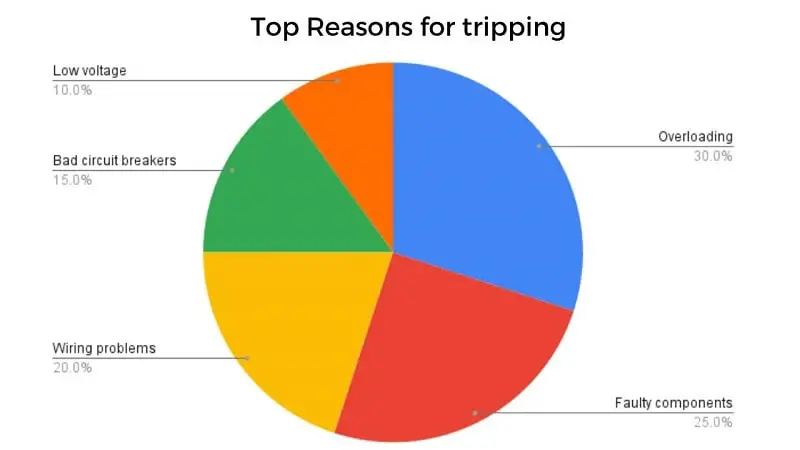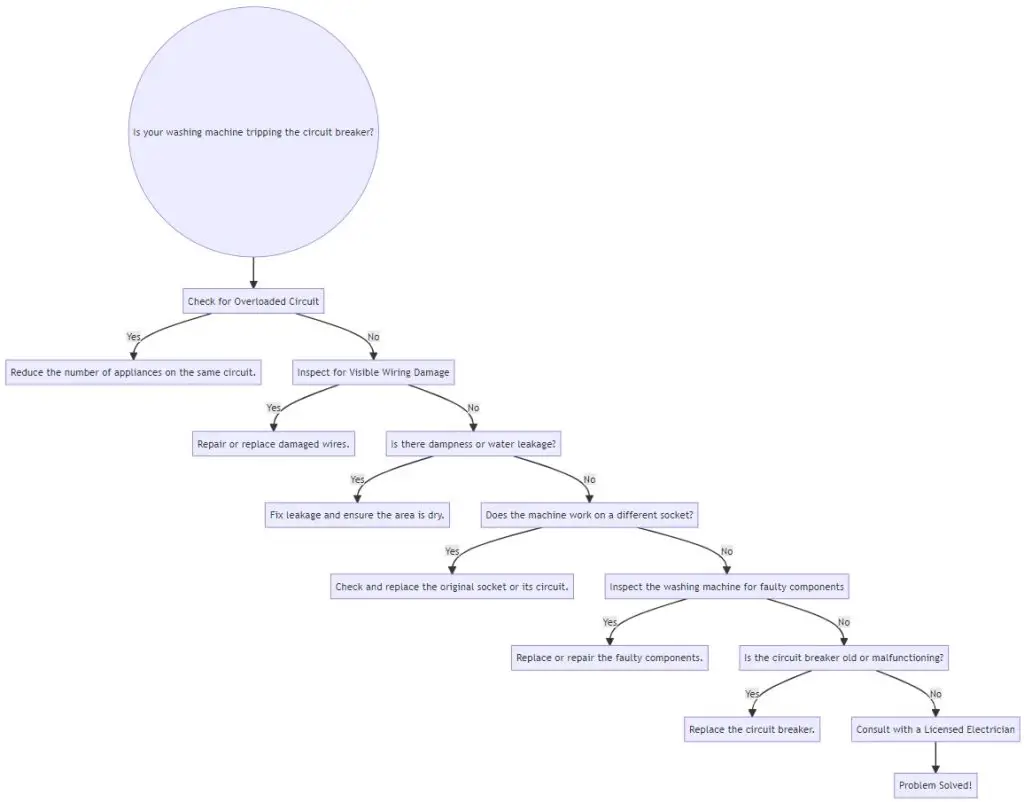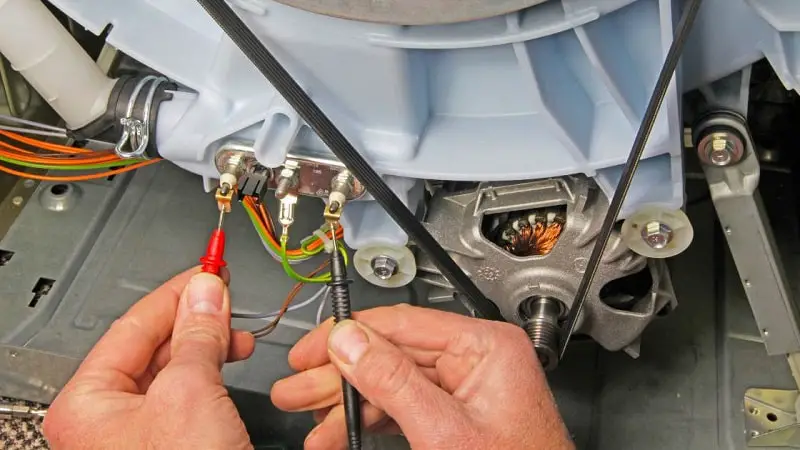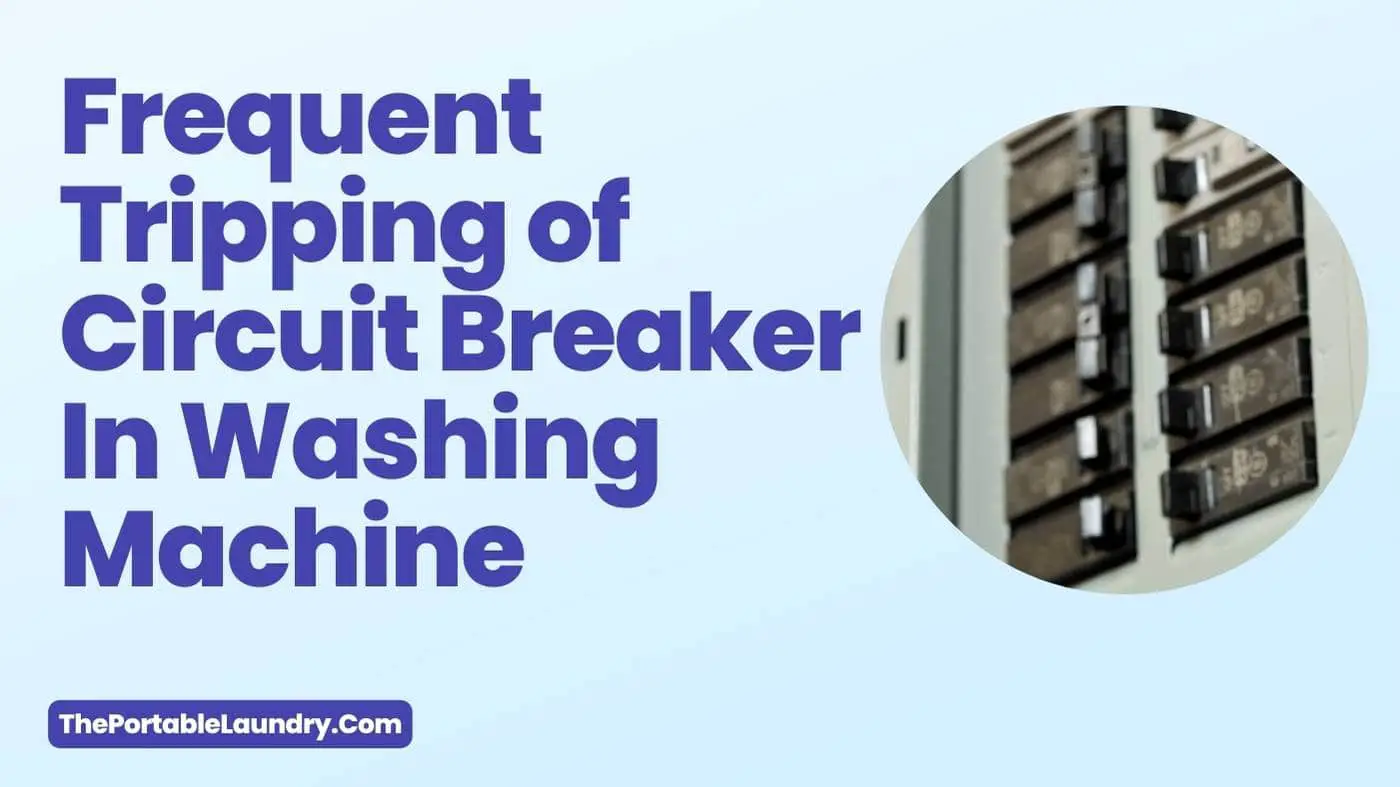When a washing machine experiences frequent tripping of circuit breaker, it can be a signal of various underlying issues.
Circuit breakers are key in preventing overcurrent and safeguarding appliances from potential harm.
Addressing the problem of a breaker tripping when using your washer is crucial, as ignoring it might lead to overloaded circuits or even safety hazards.
It’s essential to recognize and resolve this concern promptly to ensure the smooth operation of your laundry appliance.
In this post, we will go through the possible causes of frequent Tripping of circuit breakers In washing machines and practical solutions.
Table of Contents
Common Reasons for Washing Machine Tripping

When your washing machine interrupts your daily chores by repeatedly causing the circuit breaker to trip, understanding the root cause becomes essential.
Here are some common reasons why there is frequent tripping:
Tripping during specific functions
At times, the circuit breaker tripping occurs during particular cycles or functions of the washing machine.
This might hint at specific components being stressed or malfunctioning during those particular functions.
Dampness
Impact of cold weather and damp environments: Moist conditions, especially in cold and damp settings, can introduce unwanted moisture into the machine. This moisture can interact with the electrical circuitry, leading to potential ground faults or triggering Residual Current Devices (RCD).
Potential effects on sensitive components: Moist environments can affect the washing machine’s delicate electrical components and the risk of short circuits or ground faults heightens, especially in the internal wiring and motors, causing frequent circuit breaker tripping.
Leakage Issues
Water leakages within the machine can create pathways for electricity, leading to ground faults. A small leak can escalate the chances of your washing machine causing the circuit breaker to trip.
Timer Issues
The timer controls multiple electrical components synchronously.
A malfunction can cause an overload or short circuit, prompting the breaker to trip.
Issues with door latch assemblies
Modern washing machines have safety mechanisms, ensuring the machine operates only when the door is securely latched.
A faulty latch can send erratic signals, leading to circuit breaker tripping.
Problematic Control switches
The control switches regulate various machine operations.
A malfunctioning switch can cause inconsistencies in power flow and lead to breaker tripping.
Drain pump Issues
The drain pump expels water from the machine and if it malfunctions, it can cause electrical irregularities, leading to the tripping of the circuit breaker.
Identifying these culprits should be your first step towards effectively troubleshooting washing machine circuit breaker problems and ensuring seamless operation.
Overloaded Circuit
If too many appliances or devices are connected to the same circuit as the washing machine, it can lead to an overcurrent situation, causing the circuit breaker to trip.
This is the circuit breaker doing its job to prevent potential electrical fires.
Short Circuit
A short circuit occurs when live wires come into contact with neutral wires.
Inside the washing machine, this can be due to faulty or deteriorated wiring.
A short circuit can cause a sudden spike in current, leading the breaker to trip.
Ground Fault
A ground fault happens when a live wire touches a grounded portion of the washing machine (like its metal frame).
This can also lead to a significant increase in current, causing the Ground Fault Circuit Interrupter (GFCI) or the Residual Current Device (RCD) to trip.
Faulty Appliances
The washing machine itself might be faulty i.e., worn-out components, motor issues, or internal electrical problems can lead to increased current draw or short circuits.
Troubleshooting Steps for Washing Machine Circuit Breaker Issues

The process of troubleshooting washing machine circuit breaker problems can be understood by categorizing it into three main sections.
Let’s take a quick look into each section for a comprehensive diagnosis:
Checking Electrical Connections
Inspecting plug wiring and cables: Begin by ensuring that the washing machine’s plug wiring is securely connected and not damaged. Loose or frayed wires can cause an inconsistent power supply leading to circuit breaker tripping. Also, a short circuit inside the machine can trip the breaker. If that’s the case, disconnect the washing machine from power and check for burnt, frayed, or damaged wires inside the washer, if you aren’t comfortable doing this, consider hiring a professional.
Testing for blown cables and plug tops: Use a circuit tester or multimeter to check for the continuity of the cables. A discontinuity indicates a blown cable, which can cause short circuits.
Verifying power supply and sockets: Ensure that the power sockets are delivering the required voltage using a voltage tester since a low voltage supply can sometimes lead to washer malfunctions.
Evaluating the condition of the terminal block: The terminal block is where the machine’s cable connects to its internal wiring. So, if it’s damaged or corroded it can be a potential reason for frequent tripping of the circuit breaker.
Unplug Other Devices: If there are other appliances or devices connected to the same circuit, unplug them. This will reduce the load on the circuit and help identify if the issue is an overloaded circuit.
Check for Water Leaks: Water and electricity are a dangerous combination. Inspect your washing machine for any water leaks. If there’s a leak, it could be causing a short circuit, which would trip the breaker.
Test in a Different Outlet: If possible, plug the washing machine into a different outlet, preferably on a different circuit. If the breaker still trips, it indicates a problem with the washing machine. If it doesn’t, there might be a problem with the original outlet or circuit.
Door Locks and Main Power Switches
Understanding the role of safety interlocks: Modern washing machines have safety interlocks ensuring operation only with a securely closed door. A malfunctioning interlock can interrupt the power flow, causing the breaker to trip.
Identifying issues with door locks: A faulty door lock can lead to incomplete electrical circuits, leading to power inconsistencies. So, inspect the door lock for visible damages or use a multimeter to test its switch.
Power Issues When Starting a Program
Components that may cause power issues: Several internal components like motors, timers, or control switches might malfunction when a program starts. This can lead to sudden spikes or drops in power.
Could the tripping be due to a ground-fault circuit interrupter (GFCI)?
Yes, a Ground-Fault Circuit Interrupter (GFCI) can trip due to issues like ground faults, overloaded circuits, faulty wiring, water intrusion, or spliced circuits. Tripping acts as a safety measure against electrical shocks or fires. Regularly check your electrical system and keep it away from moisture to prevent unwanted GFCI trips.
Safety Precautions When Troubleshooting Washing Machines
Ensuring safety is paramount when dealing with electrical appliances.
Here are crucial steps to ensure your safety when addressing frequent tripping of circuit breakers in washing machines:
Always Disconnect Power Before Starting Work
Before diving into any troubleshooting or DIY repairs, the very first step is to disconnect the power.
This ensures that there’s no active electrical current flowing, which could lead to short circuits or other hazards.
It’s the golden rule of working with any electrical device, not just washing machines.
The Role of Multimeters in Testing
When diagnosing circuit breaker tripping issues, a multimeter proves invaluable.
This tool can measure voltage, resistance, and current, aiding in identifying faulty electrical circuits or components.
However, it’s important to ensure you’re using the multimeter correctly.
So, the key is to familiarize yourself with its functions and always test on a known power source first to ensure accurate readings.
Recognizing When Professional Help is Needed
While many washing machine circuit breaker problems can be diagnosed at home, there are instances when the situation might be beyond your understanding or ability (common with complex modern-day washers).
In such cases, it’s essential to acknowledge the limitations and seek professional appliance repair assistance.
Not only does this ensure a proper and safe repair, but it also prevents potential circuit breaker tripping in the future caused by incorrect fixes.
Conflicting Advice: Seeking Professional Help
Being a homeowner, you may consult different professionals like a builder’s electrician or an appliance store technician, but at times their responses might muddle the waters instead of clearing them.
For example, the builder’s electrician may suggest a quick test by using an extension cord i.e., to connect the washing machine to another outlet in the laundry room.
If the circuit breaker tripping continues, this could hint at an internal machine defect.
While this seems logical, the outcome might not offer clarity, especially if the appliance store technician has a different view.
The appliance store’s technician at times after examining the washing machine, could find no glaring defects.
Their diagnosis?
The problem might be the washing machine being connected to a GFCI (Ground Fault Circuit Interrupter) circuit.
Their recommendation might be a shift to a standard 20-amp circuit.
This advice, however, brings up concerns about adhering to electrical codes.
Navigating Codes and Interpretations
Decoding electrical codes becomes a key challenge in such situations.
Interpretations can differ based on location, jurisdiction, and individual understanding.
Here, the homeowner may face a huge dilemma, here’s why.
They’ve been informed by the builder about the local code specifying that washing machines in laundry areas must be connected to GFCI circuits. This seemingly contradicts the technician’s advice.
So, What does this mean for homeowners trying to troubleshoot frequent tripping of circuit breakers in washing machines?
It underscores the need to not only consult professionals but also to cross-reference their advice with local electrical regulations.
Understanding the nuances of electrical codes ensures that solutions are both safe and compliant.
The bottom line is, that while professionals bring expertise and experience, homeowners need to be proactive.
Cross-checking advice, understanding the local codes, and considering multiple perspectives will lead to the most informed and safest decision when addressing washing machine circuit breaker tripping issues.
Community Insights: A Valuable Resource from Personal Research
Online community can be invaluable when trying to find a solution for a given problem.
While looking for possible solutions for tripping issues, the community’s collective wisdom offered a fresh perspective on how to address this recurring issue.
Here’s what I unearthed from my research (I have divided the solution into three parts based on the online discussions in different forums):
Using Filter Solutions
On one of the forums, a user passionately described their success using specialized filters.
These filters are designed to counteract potential electrical noise or surges that might cause the circuit to trip.
By integrating such filters into their setup, they managed to stabilize the electrical connection to their washing machine, drastically reducing disruptions.
Consulting with a Licensed Electrician
Another recurring piece of advice that caught my attention was the emphasis on professional intervention.
There are many members who vouch for the expertise of licensed electricians.
Drawing from their experiences, they highlighted how these experts, with their profound understanding of local electrical codes, provided clarity and practical solutions, ensuring the smooth operation of their washing machines.
Contacting the Builder
A particularly insightful thread discussed the value of reverting to the builder for guidance, especially when electrical code interpretations were in question.
Users recounted how initiating a dialogue with builders shed light on the complexities of local regulations, paving the way for a more informed approach.
Washing Machine Tripping Prevention Tips

The inconvenience and potential hazards posed by a washing machine tripping the circuit breaker can be frustrating.
To ensure the consistent and safe operation of your washing machine, consider the following prevention strategies:
Avoid Overloading
One of the most common reasons for washing machine tripping is an overloaded drum.
Overloading not only strains the motor but can also lead to unbalanced loads, causing further strain and electrical anomalies.
And when we talk about overloading, it not only means not overloading the washer in terms of laundry load size but also not overloading the switch (make sure you have a dedicated power supply for the washer).
Other appliances or devices sharing the same circuit can lead to an overloaded circuit, especially when multiple appliances are in use simultaneously.
Maintain Cleanliness
Ensure that the drum and compartments are free from any debris or leftover detergent.
Accumulated lint, lost coins, or stray items can sometimes cause internal blockages or interfere with the machine’s operation, leading to increased power consumption.
Regular Wiring and Hose Inspection
Over time, the internal wiring and hoses of the washing machine can wear out or become damaged.
Regularly inspect these components for any signs of wear, tear, or damage.
Frayed wires or cracked hoses can lead to electrical shorts or leaks, which can cause the circuit breaker to trip.
Routine Professional Service
Even with regular home maintenance, it’s essential to have your washing machine serviced by a qualified appliance technician at recommended intervals.
They can identify potential problems early, ensuring the appliance operates efficiently and safely.
Use Quality Surge Protectors
While washing machines themselves don’t typically require surge protectors, if your laundry room has other electrical appliances, using a quality surge protector can safeguard the entire room from voltage spikes.
Stay Updated with Manufacturer’s Recommendations
Always refer to the washing machine’s user manual for any specific maintenance or operational guidelines.
Manufacturers often provide tailored advice for optimal performance and safety.
Final Thoughts
Addressing the issue of a washing machine tripping the circuit breaker is more than just a routine home maintenance task, it’s a matter of ensuring safety and functionality in one’s household.
By recognizing the symptoms of a faulty circuit breaker and understanding the complexities of a washing machine’s electrical needs, you can prevent potential hazards and prolong the lifespan of your laundry appliance many folds.
You May Also Like
- Frigidaire Washing Machine Troubleshooting (Best Solutions)
- Roper Washing Machine Troubleshooting: Causes & solutions
- What does dE on LG washer Indicate? (Troubleshoot dE error)
- Why is the Whirlpool washer not agitating? (Troubleshooting)
- The Ultimate Guide to troubleshoot Portable Washing Machine Issues
- Resetting Washing Machine Timer (Step by step guide)

